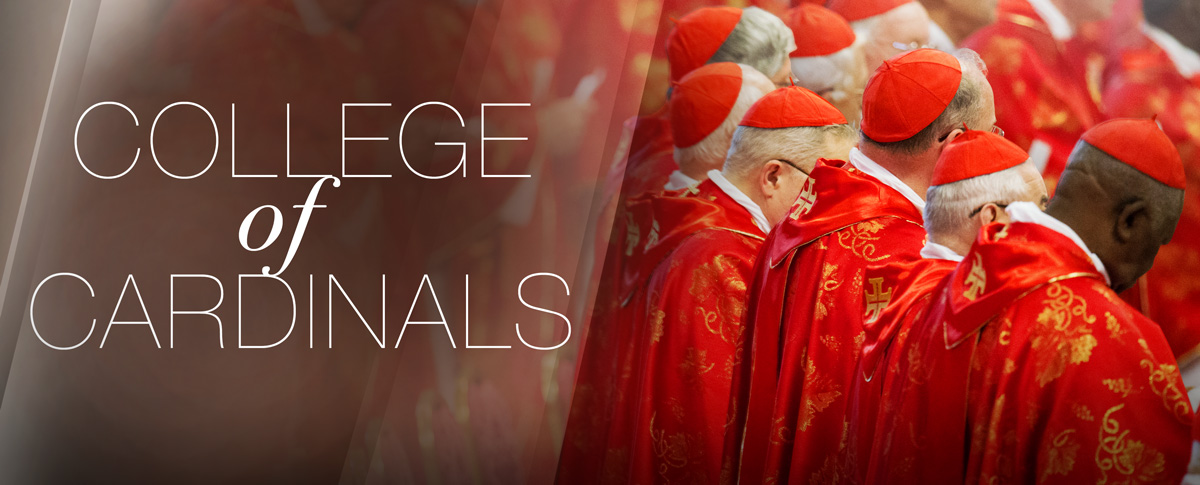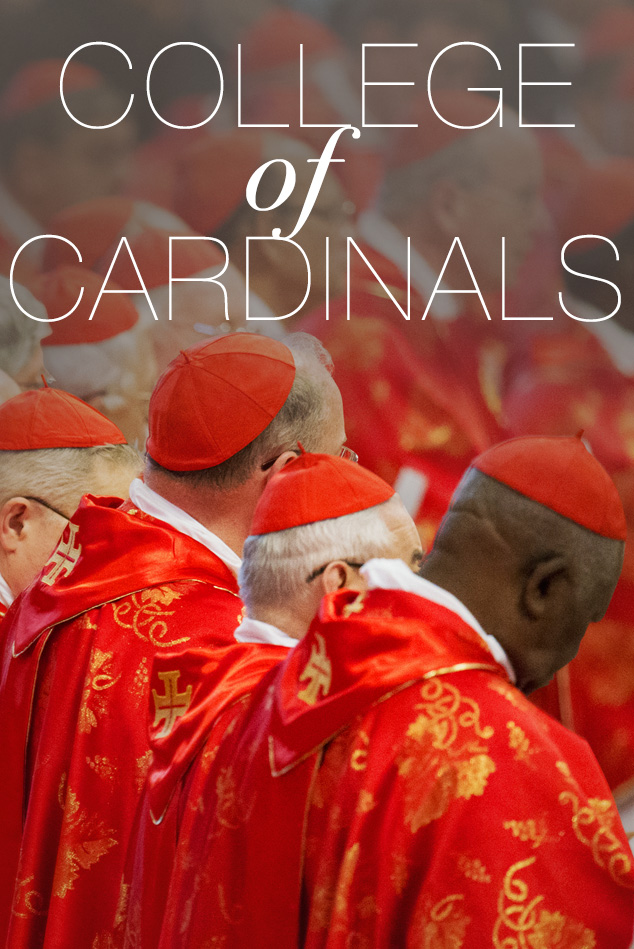The College of Cardinals is composed of the men whom the Pope has elevated to the dignity of Cardinal, entrusting them with the duty to be his close advisors and collaborators, and to elect his successor. The decisions of the College are made collectively, and ratified by the Pope, unless of course there is no Pope. During such a Papal Interregnum the Cardinals gather in General Congregation to decide by majority vote on the funeral of the Pope, the beginning of the Conclave to elect a new Pope, as well as any ordinary business of the Holy See which cannot wait, in keeping with papal law, currently the Apostolic Constitution Universi Dominici Gregis.
The ecclesiastical rank of Cardinal dates from the time of Pope Sylvester I, around 315 AD. It was given to the closest advisors of the Pope. With time it came to be reserved to those whom the Pope had given pastoral responsibility for the 7 suburban dioceses of the Roman Province, as well as the Roman churches, and deaconries. Today the Cardinals each possess only a titular office as a bishop, priest or deacon of Rome, but without actual responsibility for the dioceses, parishes and deaconries. The actual offices held by Cardinals today are within the Roman Curia or as archbishop of an important diocese. Cardinals, therefore, are generally bishops, though the Popes may grant exceptions. In recent decades this exception has been granted for theologians the Popes have wished to honor. Under current law, a Cardinal must at least be a priest.
The existence of antipopes is one of the most unusual features of Church history. The first to be declared Pope, but be considered invalidly elected at the time or by history was St. Hippolytus, who disagreed with the Pope of the day but was later reconciled and died for the faith. Most antipopes have come about due to the intrigues of cardinals, secular princes or Roman nobility.
An Ordinary Consistory is when “(A)ll the cardinals, at least all those present in the city of Rome, are called together … to be consulted on certain serious matters which nevertheless occur rather frequently, or to carry out certain very solemn acts” (CCC canon 353, §2).
An Extraordinary Consistory is when “(A)ll the cardinals are called together … when the special needs of the Church or the conducting of more serious affairs suggests that it should be held” (CCC canon 353, §3).
Close advisors to the Pope have been called Cardinals, from the Latin carde for hinge, since probably the 4th century. Since 1059 Cardinals have served as the exclusive electors of the Popes, and the College itself was given its current form in 1150. Over the centuries the number of Cardinals was held below 70, a biblically significant number, since there were seventy elders assisting Moses in leading Israel and 70 men, besides the Apostles, assisting Jesus in His ministry (Luke 10:1). However, both Pope Paul VI and Pope John Paul II went beyond this number in order to internationalize the College with bishops from around the world. Today there are 117 Electors out of a total of 183 Cardinals, a number which includes those who have reached the age of ineligibility to vote, 80 years.
The College is internally divided into three orders or ranks, Cardinal Bishops, Cardinal Priests and Cardinal Deacons. This division reflects its early history when the advisors and electors of the Pope were taken from the clergy of Rome. Today each Cardinal holds a title, or titular office (i.e. without actual authority), in the Diocese and Province of Rome, such as Cardinal Bishop of Ostia, Cardinal Priest of the Church of Saint John, or Cardinal Deacon of the Holy Names of Jesus and Mary.
The College is presided over by the Dean, who is assisted by a Vice-Dean. Both are elected from the rank of Cardinal Bishops, by their fellow Cardinal Bishops, and confirmed in office by the Pope.
The Dean of the College of Cardinals is a Cardinal Bishop who is elected by his fellow Cardinal Bishops and confirmed in office by the Pope. Although he presides over the consistories and congregations of the College, he has no authority over other Cardinals. The decisions of the College are entirely collegial (collective). The Dean of the College convokes the Cardinals when the Pope dies and presides over their Congregations and the Conclave. He is the one who asks the electee to accept election as Pope.
A Conclave is the special gathering of Cardinals for the purpose of electing a Pope. It is governed minutely by Papal Law, currently the Apostolic Constitution Universi Dominici Gregis. For more information on the Conclave, and all matters concerning the period between the reign of one Pope and another, see the Papal Interregnum section.
The Cardinal Electors are those members of the College of Cardinals who have not reached their 80th Birthday on the day a “Vacancy of the Apostolic See” occurs, whether by the death or the resignation of the Supreme Pontiff. That is, if they turn 80 years of age on or before the day a Pope dies or resigns, they are ineligible to vote in the Conclave to elect his successor. However, if they turn 80 years of age the day after the Pope dies or resigns, they are eligible to enter the Conclave and vote. Interestingly, even if a Cardinal cannot vote he can be elected.
Throughout history many Cardinals have been holy men. Some are numbered among the saintly popes, others completed their lives in service to the Church as Cardinals. Below are some of those who did so, and who are numbered among the saints, blesseds and venerables of the Church.
Cardinals who hold the more important offices in the Roman Curia or who, being Patriarchs of Eastern Catholic Churches, have been granted equivalent dignity in law since Pope Paul VI, are called Cardinal Bishops. The smallest of the three ranks of Cardinals it traces its history to the role played in the early Church by the bishops of 7 dioceses surrounding Rome, called the suburcarian (suburban) Sees of Rome. Cardinal Bishops are said to hold the title, as opposed to the actual office, of those 7 Sees. The Cardinal Dean holds two titles, Ostia and the one he holds at the time of his promotion to Dean. Thus, there are only such six Cardinal Bishops at a time, plus however many Eastern Patriarchs there are.
Cardinals Priests are those Cardinals who hold the middle, and by far the most numerous, rank of the College of Cardinals. They include officials of the Roman Curia, as well as Archbishops of major dioceses from around the world. Cardinal Priests hold title to a particular church of the Roman See, a dim historical reflection of the very early practice of the clergy of Rome participating in the election of the Pope. Within the rank of Cardinal Priest cardinals hold seniority based on date of appointment, and may even advance by promotion by the Pope to the higher grade of Cardinal Bishop.
MembersCardinals Deacons hold the lowest of the ranks of Cardinals. There ranks include officials of the Roman Curia, and theologians honored by the Pope for their contribution to the Church. In the early centuries there were 7 deacons who administered seven districts of the Roman diocese, as well as 7 deacons who assisted in the papal household. Although the rank of Cardinal Deacon numbers more than 14 today, they hold title as if assigned to a church in one of three deaconries of Rome. Cardinal Deacons may advance by promotion by the Pope to the higher ranks of the College of Cardinals.
MembersThe gathering of the Cardinals to advise the Pope, or assist him in his duties, is called a Congregation. Also, the major departments of the Roman Curia are called Congregations because they are made up of a number of voting Cardinals headed by a Cardinal Prefect. During the vacancy of the Apostolic See, from the time of the death of the Pope until the beginning of the election of his successor, the decisions regarding the ordinary affairs of the Holy See, as well as the funeral, burial and election of the Pope, are decided by such gatherings of the Cardinals.
General Congregations are meetings of all the Cardinals who are not legitimately impeded from attending by sickness or other lawful reasons. They decide the more significant matters related to the Papal Interregnum. The scope of their authority is entirely governed by the Apostolic Constitution Universi Dominici Gregis, which permits absolutely no innovations in the functioning of the Holy See while there is no Pope. The General Congregation, however, can decide disputed points of interpretation of the law.
Particular Congregations are composed of the Camerlengo (Chamberlain) of the Holy Roman Church, and 3 other Cardinals, called Assistants, chosen by lot from each of the three ranks of Cardinals. These Particular Congregations handle the ordinary business of the Roman Church, referring anything significant to the General Congregation. New Assistants are elected by lot after they have served for three days.

